Clinical Leadership: Transactional Analysis and Feedback Application
VerifiedAdded on 2022/12/28
|10
|2617
|88
Essay
AI Summary
This essay provides a critical analysis of nursing leadership, focusing on the application of Eric Berne's transactional analysis model and Pendleton's feedback model in clinical settings. It examines a feedback video scenario, evaluating the verbal and non-verbal communication between a mentor nurse and a student nurse. The analysis highlights the importance of understanding ego states (Parent, Adult, Child) in effective communication and the steps involved in providing constructive feedback. The essay also reflects on the author's personal learning and intended application of these leadership principles to improve interactions with colleagues and enhance patient care, emphasizing the value of self-awareness and continuous professional development within the nursing profession. Desklib offers a wealth of resources, including solved assignments and past papers, to support nursing students in their academic and professional journeys.
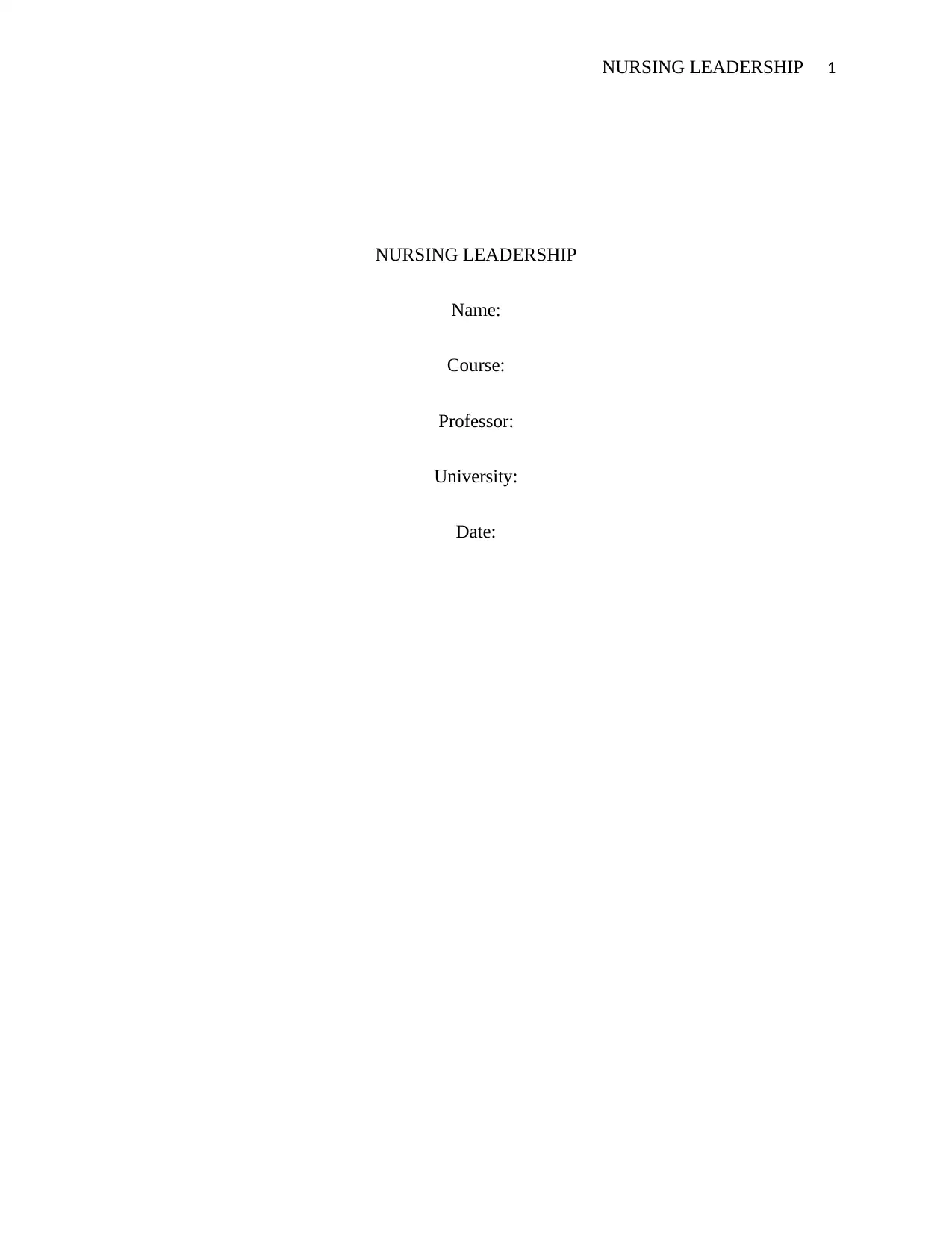
NURSING LEADERSHIP 1
NURSING LEADERSHIP
Name:
Course:
Professor:
University:
Date:
NURSING LEADERSHIP
Name:
Course:
Professor:
University:
Date:
Paraphrase This Document
Need a fresh take? Get an instant paraphrase of this document with our AI Paraphraser
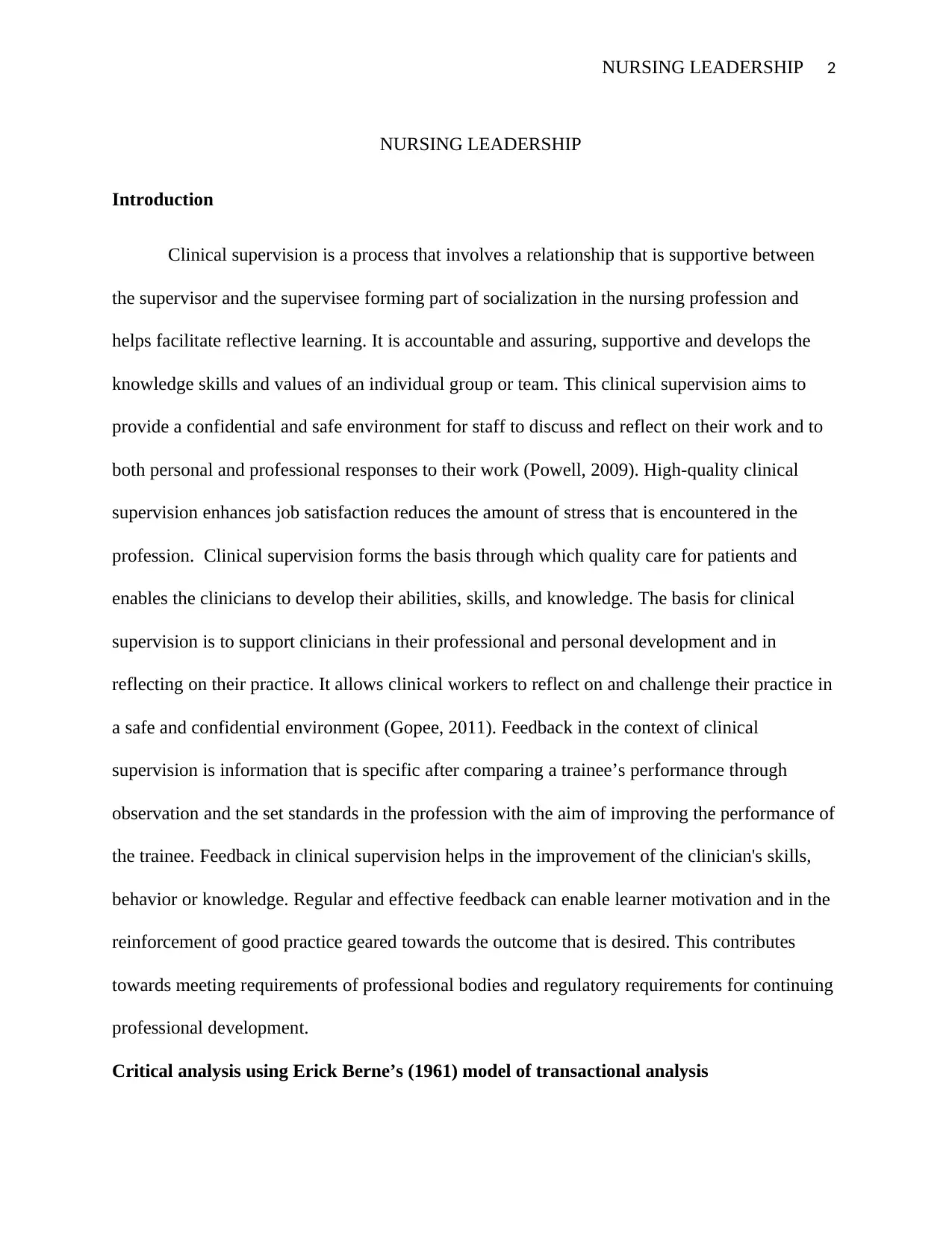
NURSING LEADERSHIP 2
NURSING LEADERSHIP
Introduction
Clinical supervision is a process that involves a relationship that is supportive between
the supervisor and the supervisee forming part of socialization in the nursing profession and
helps facilitate reflective learning. It is accountable and assuring, supportive and develops the
knowledge skills and values of an individual group or team. This clinical supervision aims to
provide a confidential and safe environment for staff to discuss and reflect on their work and to
both personal and professional responses to their work (Powell, 2009). High-quality clinical
supervision enhances job satisfaction reduces the amount of stress that is encountered in the
profession. Clinical supervision forms the basis through which quality care for patients and
enables the clinicians to develop their abilities, skills, and knowledge. The basis for clinical
supervision is to support clinicians in their professional and personal development and in
reflecting on their practice. It allows clinical workers to reflect on and challenge their practice in
a safe and confidential environment (Gopee, 2011). Feedback in the context of clinical
supervision is information that is specific after comparing a trainee’s performance through
observation and the set standards in the profession with the aim of improving the performance of
the trainee. Feedback in clinical supervision helps in the improvement of the clinician's skills,
behavior or knowledge. Regular and effective feedback can enable learner motivation and in the
reinforcement of good practice geared towards the outcome that is desired. This contributes
towards meeting requirements of professional bodies and regulatory requirements for continuing
professional development.
Critical analysis using Erick Berne’s (1961) model of transactional analysis
NURSING LEADERSHIP
Introduction
Clinical supervision is a process that involves a relationship that is supportive between
the supervisor and the supervisee forming part of socialization in the nursing profession and
helps facilitate reflective learning. It is accountable and assuring, supportive and develops the
knowledge skills and values of an individual group or team. This clinical supervision aims to
provide a confidential and safe environment for staff to discuss and reflect on their work and to
both personal and professional responses to their work (Powell, 2009). High-quality clinical
supervision enhances job satisfaction reduces the amount of stress that is encountered in the
profession. Clinical supervision forms the basis through which quality care for patients and
enables the clinicians to develop their abilities, skills, and knowledge. The basis for clinical
supervision is to support clinicians in their professional and personal development and in
reflecting on their practice. It allows clinical workers to reflect on and challenge their practice in
a safe and confidential environment (Gopee, 2011). Feedback in the context of clinical
supervision is information that is specific after comparing a trainee’s performance through
observation and the set standards in the profession with the aim of improving the performance of
the trainee. Feedback in clinical supervision helps in the improvement of the clinician's skills,
behavior or knowledge. Regular and effective feedback can enable learner motivation and in the
reinforcement of good practice geared towards the outcome that is desired. This contributes
towards meeting requirements of professional bodies and regulatory requirements for continuing
professional development.
Critical analysis using Erick Berne’s (1961) model of transactional analysis
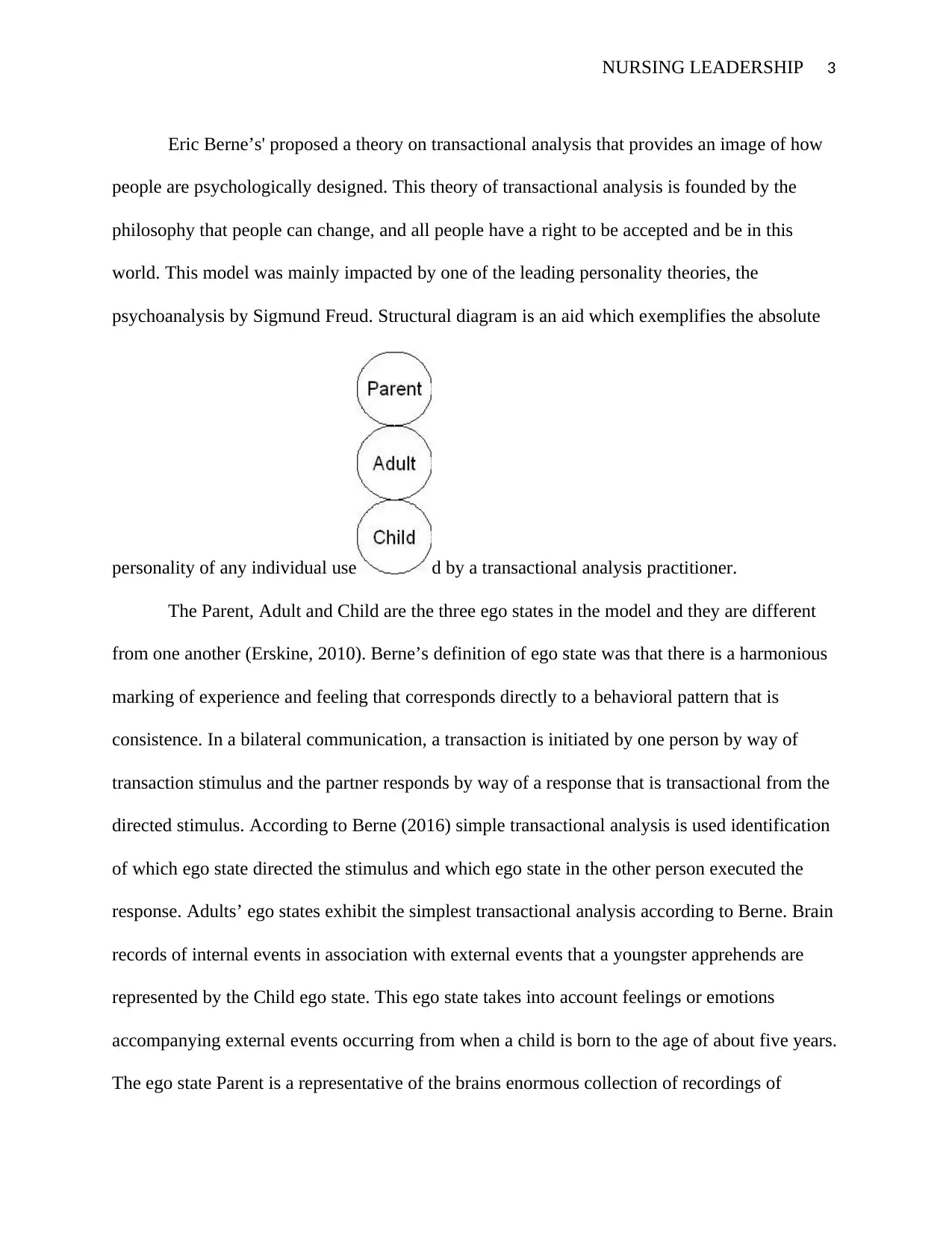
NURSING LEADERSHIP 3
Eric Berne’s' proposed a theory on transactional analysis that provides an image of how
people are psychologically designed. This theory of transactional analysis is founded by the
philosophy that people can change, and all people have a right to be accepted and be in this
world. This model was mainly impacted by one of the leading personality theories, the
psychoanalysis by Sigmund Freud. Structural diagram is an aid which exemplifies the absolute
personality of any individual use d by a transactional analysis practitioner.
The Parent, Adult and Child are the three ego states in the model and they are different
from one another (Erskine, 2010). Berne’s definition of ego state was that there is a harmonious
marking of experience and feeling that corresponds directly to a behavioral pattern that is
consistence. In a bilateral communication, a transaction is initiated by one person by way of
transaction stimulus and the partner responds by way of a response that is transactional from the
directed stimulus. According to Berne (2016) simple transactional analysis is used identification
of which ego state directed the stimulus and which ego state in the other person executed the
response. Adults’ ego states exhibit the simplest transactional analysis according to Berne. Brain
records of internal events in association with external events that a youngster apprehends are
represented by the Child ego state. This ego state takes into account feelings or emotions
accompanying external events occurring from when a child is born to the age of about five years.
The ego state Parent is a representative of the brains enormous collection of recordings of
Eric Berne’s' proposed a theory on transactional analysis that provides an image of how
people are psychologically designed. This theory of transactional analysis is founded by the
philosophy that people can change, and all people have a right to be accepted and be in this
world. This model was mainly impacted by one of the leading personality theories, the
psychoanalysis by Sigmund Freud. Structural diagram is an aid which exemplifies the absolute
personality of any individual use d by a transactional analysis practitioner.
The Parent, Adult and Child are the three ego states in the model and they are different
from one another (Erskine, 2010). Berne’s definition of ego state was that there is a harmonious
marking of experience and feeling that corresponds directly to a behavioral pattern that is
consistence. In a bilateral communication, a transaction is initiated by one person by way of
transaction stimulus and the partner responds by way of a response that is transactional from the
directed stimulus. According to Berne (2016) simple transactional analysis is used identification
of which ego state directed the stimulus and which ego state in the other person executed the
response. Adults’ ego states exhibit the simplest transactional analysis according to Berne. Brain
records of internal events in association with external events that a youngster apprehends are
represented by the Child ego state. This ego state takes into account feelings or emotions
accompanying external events occurring from when a child is born to the age of about five years.
The ego state Parent is a representative of the brains enormous collection of recordings of
⊘ This is a preview!⊘
Do you want full access?
Subscribe today to unlock all pages.

Trusted by 1+ million students worldwide
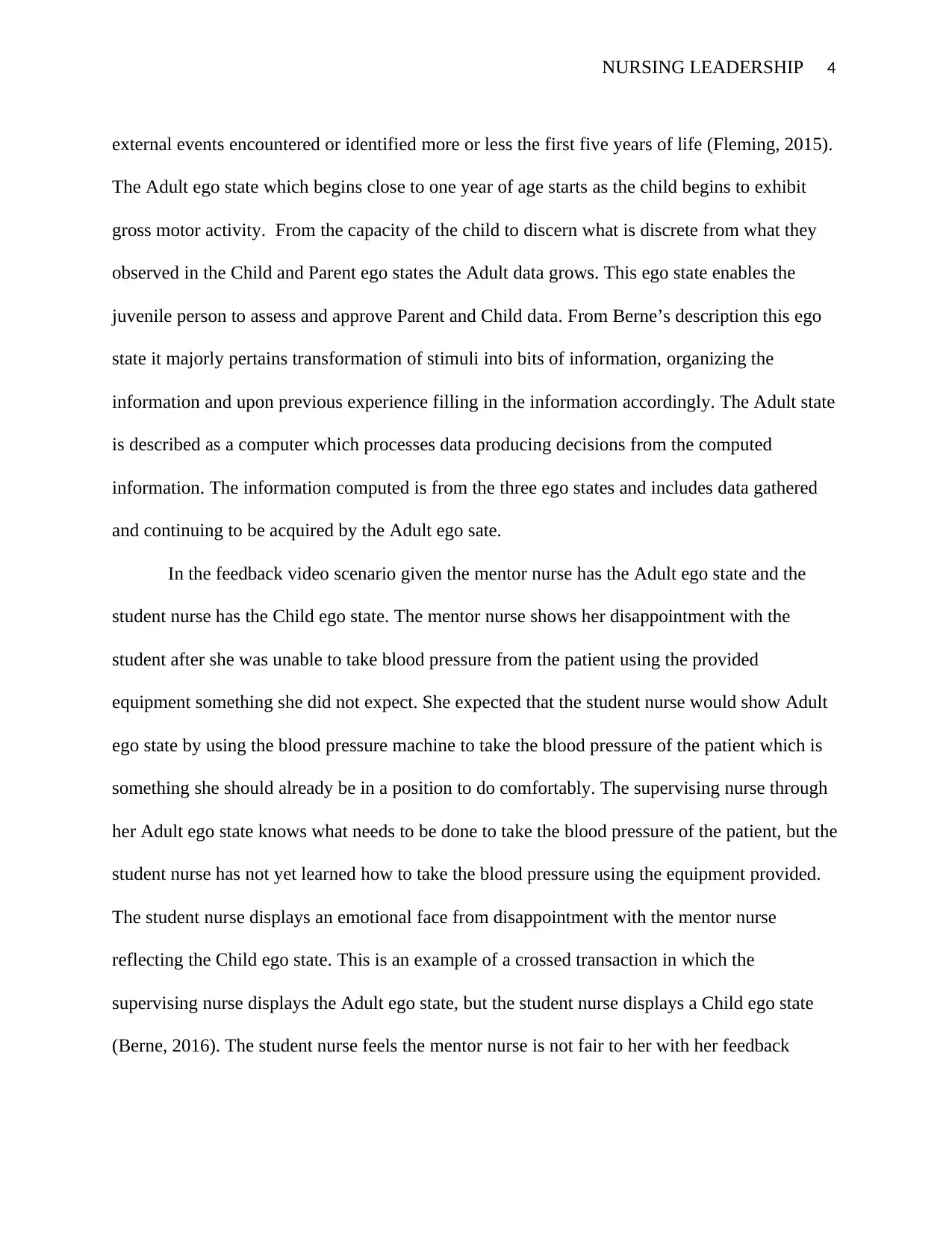
NURSING LEADERSHIP 4
external events encountered or identified more or less the first five years of life (Fleming, 2015).
The Adult ego state which begins close to one year of age starts as the child begins to exhibit
gross motor activity. From the capacity of the child to discern what is discrete from what they
observed in the Child and Parent ego states the Adult data grows. This ego state enables the
juvenile person to assess and approve Parent and Child data. From Berne’s description this ego
state it majorly pertains transformation of stimuli into bits of information, organizing the
information and upon previous experience filling in the information accordingly. The Adult state
is described as a computer which processes data producing decisions from the computed
information. The information computed is from the three ego states and includes data gathered
and continuing to be acquired by the Adult ego sate.
In the feedback video scenario given the mentor nurse has the Adult ego state and the
student nurse has the Child ego state. The mentor nurse shows her disappointment with the
student after she was unable to take blood pressure from the patient using the provided
equipment something she did not expect. She expected that the student nurse would show Adult
ego state by using the blood pressure machine to take the blood pressure of the patient which is
something she should already be in a position to do comfortably. The supervising nurse through
her Adult ego state knows what needs to be done to take the blood pressure of the patient, but the
student nurse has not yet learned how to take the blood pressure using the equipment provided.
The student nurse displays an emotional face from disappointment with the mentor nurse
reflecting the Child ego state. This is an example of a crossed transaction in which the
supervising nurse displays the Adult ego state, but the student nurse displays a Child ego state
(Berne, 2016). The student nurse feels the mentor nurse is not fair to her with her feedback
external events encountered or identified more or less the first five years of life (Fleming, 2015).
The Adult ego state which begins close to one year of age starts as the child begins to exhibit
gross motor activity. From the capacity of the child to discern what is discrete from what they
observed in the Child and Parent ego states the Adult data grows. This ego state enables the
juvenile person to assess and approve Parent and Child data. From Berne’s description this ego
state it majorly pertains transformation of stimuli into bits of information, organizing the
information and upon previous experience filling in the information accordingly. The Adult state
is described as a computer which processes data producing decisions from the computed
information. The information computed is from the three ego states and includes data gathered
and continuing to be acquired by the Adult ego sate.
In the feedback video scenario given the mentor nurse has the Adult ego state and the
student nurse has the Child ego state. The mentor nurse shows her disappointment with the
student after she was unable to take blood pressure from the patient using the provided
equipment something she did not expect. She expected that the student nurse would show Adult
ego state by using the blood pressure machine to take the blood pressure of the patient which is
something she should already be in a position to do comfortably. The supervising nurse through
her Adult ego state knows what needs to be done to take the blood pressure of the patient, but the
student nurse has not yet learned how to take the blood pressure using the equipment provided.
The student nurse displays an emotional face from disappointment with the mentor nurse
reflecting the Child ego state. This is an example of a crossed transaction in which the
supervising nurse displays the Adult ego state, but the student nurse displays a Child ego state
(Berne, 2016). The student nurse feels the mentor nurse is not fair to her with her feedback
Paraphrase This Document
Need a fresh take? Get an instant paraphrase of this document with our AI Paraphraser
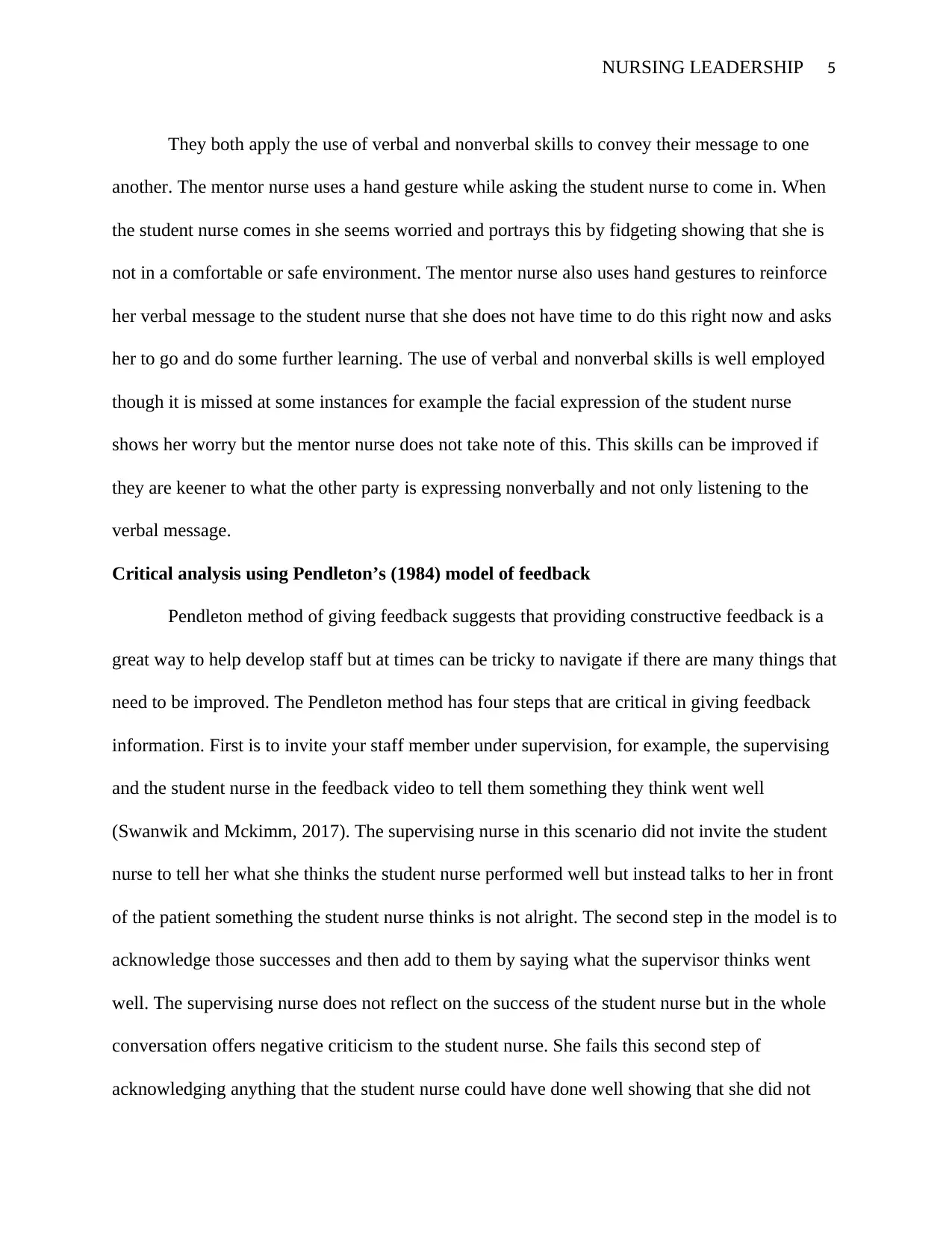
NURSING LEADERSHIP 5
They both apply the use of verbal and nonverbal skills to convey their message to one
another. The mentor nurse uses a hand gesture while asking the student nurse to come in. When
the student nurse comes in she seems worried and portrays this by fidgeting showing that she is
not in a comfortable or safe environment. The mentor nurse also uses hand gestures to reinforce
her verbal message to the student nurse that she does not have time to do this right now and asks
her to go and do some further learning. The use of verbal and nonverbal skills is well employed
though it is missed at some instances for example the facial expression of the student nurse
shows her worry but the mentor nurse does not take note of this. This skills can be improved if
they are keener to what the other party is expressing nonverbally and not only listening to the
verbal message.
Critical analysis using Pendleton’s (1984) model of feedback
Pendleton method of giving feedback suggests that providing constructive feedback is a
great way to help develop staff but at times can be tricky to navigate if there are many things that
need to be improved. The Pendleton method has four steps that are critical in giving feedback
information. First is to invite your staff member under supervision, for example, the supervising
and the student nurse in the feedback video to tell them something they think went well
(Swanwik and Mckimm, 2017). The supervising nurse in this scenario did not invite the student
nurse to tell her what she thinks the student nurse performed well but instead talks to her in front
of the patient something the student nurse thinks is not alright. The second step in the model is to
acknowledge those successes and then add to them by saying what the supervisor thinks went
well. The supervising nurse does not reflect on the success of the student nurse but in the whole
conversation offers negative criticism to the student nurse. She fails this second step of
acknowledging anything that the student nurse could have done well showing that she did not
They both apply the use of verbal and nonverbal skills to convey their message to one
another. The mentor nurse uses a hand gesture while asking the student nurse to come in. When
the student nurse comes in she seems worried and portrays this by fidgeting showing that she is
not in a comfortable or safe environment. The mentor nurse also uses hand gestures to reinforce
her verbal message to the student nurse that she does not have time to do this right now and asks
her to go and do some further learning. The use of verbal and nonverbal skills is well employed
though it is missed at some instances for example the facial expression of the student nurse
shows her worry but the mentor nurse does not take note of this. This skills can be improved if
they are keener to what the other party is expressing nonverbally and not only listening to the
verbal message.
Critical analysis using Pendleton’s (1984) model of feedback
Pendleton method of giving feedback suggests that providing constructive feedback is a
great way to help develop staff but at times can be tricky to navigate if there are many things that
need to be improved. The Pendleton method has four steps that are critical in giving feedback
information. First is to invite your staff member under supervision, for example, the supervising
and the student nurse in the feedback video to tell them something they think went well
(Swanwik and Mckimm, 2017). The supervising nurse in this scenario did not invite the student
nurse to tell her what she thinks the student nurse performed well but instead talks to her in front
of the patient something the student nurse thinks is not alright. The second step in the model is to
acknowledge those successes and then add to them by saying what the supervisor thinks went
well. The supervising nurse does not reflect on the success of the student nurse but in the whole
conversation offers negative criticism to the student nurse. She fails this second step of
acknowledging anything that the student nurse could have done well showing that she did not
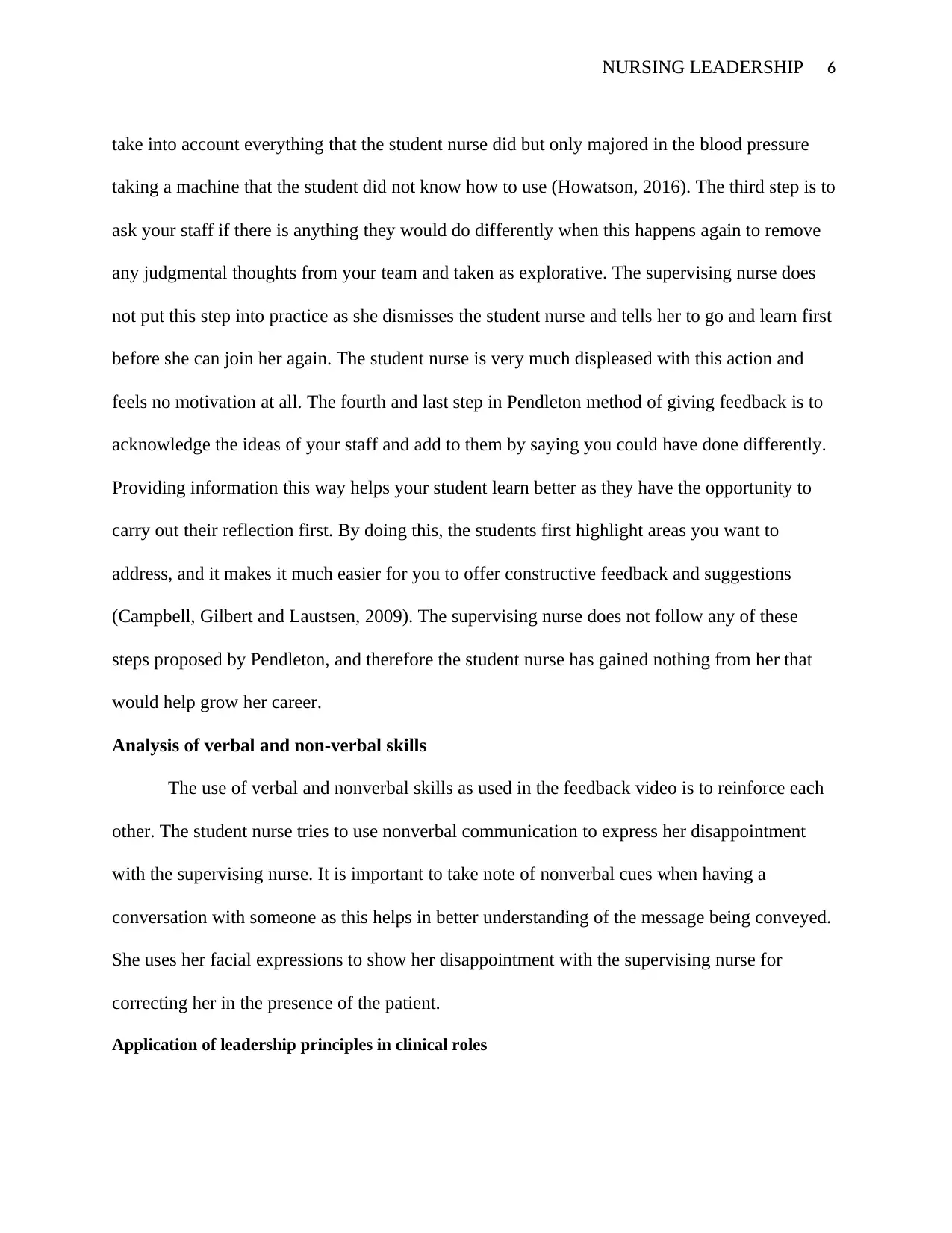
NURSING LEADERSHIP 6
take into account everything that the student nurse did but only majored in the blood pressure
taking a machine that the student did not know how to use (Howatson, 2016). The third step is to
ask your staff if there is anything they would do differently when this happens again to remove
any judgmental thoughts from your team and taken as explorative. The supervising nurse does
not put this step into practice as she dismisses the student nurse and tells her to go and learn first
before she can join her again. The student nurse is very much displeased with this action and
feels no motivation at all. The fourth and last step in Pendleton method of giving feedback is to
acknowledge the ideas of your staff and add to them by saying you could have done differently.
Providing information this way helps your student learn better as they have the opportunity to
carry out their reflection first. By doing this, the students first highlight areas you want to
address, and it makes it much easier for you to offer constructive feedback and suggestions
(Campbell, Gilbert and Laustsen, 2009). The supervising nurse does not follow any of these
steps proposed by Pendleton, and therefore the student nurse has gained nothing from her that
would help grow her career.
Analysis of verbal and non-verbal skills
The use of verbal and nonverbal skills as used in the feedback video is to reinforce each
other. The student nurse tries to use nonverbal communication to express her disappointment
with the supervising nurse. It is important to take note of nonverbal cues when having a
conversation with someone as this helps in better understanding of the message being conveyed.
She uses her facial expressions to show her disappointment with the supervising nurse for
correcting her in the presence of the patient.
Application of leadership principles in clinical roles
take into account everything that the student nurse did but only majored in the blood pressure
taking a machine that the student did not know how to use (Howatson, 2016). The third step is to
ask your staff if there is anything they would do differently when this happens again to remove
any judgmental thoughts from your team and taken as explorative. The supervising nurse does
not put this step into practice as she dismisses the student nurse and tells her to go and learn first
before she can join her again. The student nurse is very much displeased with this action and
feels no motivation at all. The fourth and last step in Pendleton method of giving feedback is to
acknowledge the ideas of your staff and add to them by saying you could have done differently.
Providing information this way helps your student learn better as they have the opportunity to
carry out their reflection first. By doing this, the students first highlight areas you want to
address, and it makes it much easier for you to offer constructive feedback and suggestions
(Campbell, Gilbert and Laustsen, 2009). The supervising nurse does not follow any of these
steps proposed by Pendleton, and therefore the student nurse has gained nothing from her that
would help grow her career.
Analysis of verbal and non-verbal skills
The use of verbal and nonverbal skills as used in the feedback video is to reinforce each
other. The student nurse tries to use nonverbal communication to express her disappointment
with the supervising nurse. It is important to take note of nonverbal cues when having a
conversation with someone as this helps in better understanding of the message being conveyed.
She uses her facial expressions to show her disappointment with the supervising nurse for
correcting her in the presence of the patient.
Application of leadership principles in clinical roles
⊘ This is a preview!⊘
Do you want full access?
Subscribe today to unlock all pages.

Trusted by 1+ million students worldwide
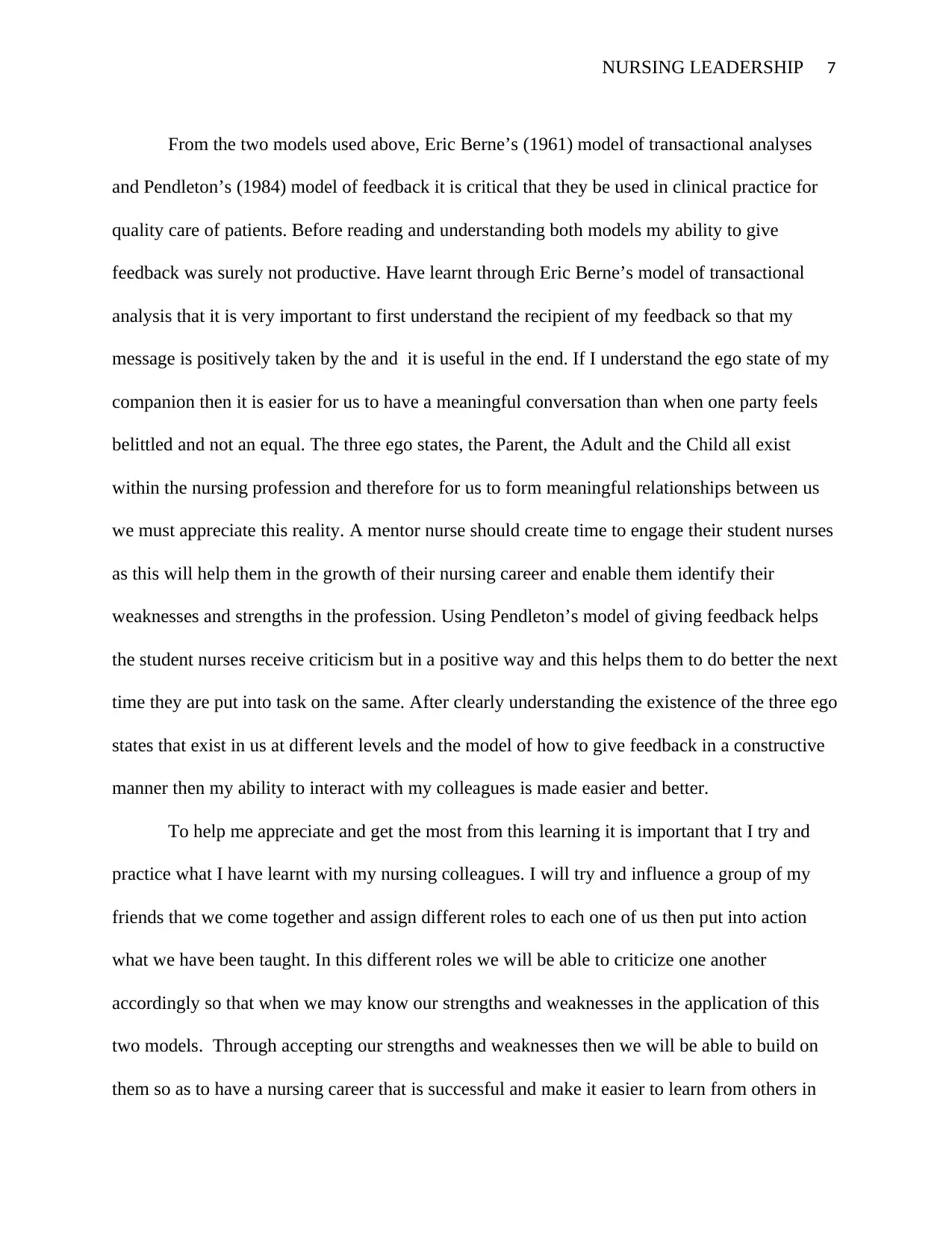
NURSING LEADERSHIP 7
From the two models used above, Eric Berne’s (1961) model of transactional analyses
and Pendleton’s (1984) model of feedback it is critical that they be used in clinical practice for
quality care of patients. Before reading and understanding both models my ability to give
feedback was surely not productive. Have learnt through Eric Berne’s model of transactional
analysis that it is very important to first understand the recipient of my feedback so that my
message is positively taken by the and it is useful in the end. If I understand the ego state of my
companion then it is easier for us to have a meaningful conversation than when one party feels
belittled and not an equal. The three ego states, the Parent, the Adult and the Child all exist
within the nursing profession and therefore for us to form meaningful relationships between us
we must appreciate this reality. A mentor nurse should create time to engage their student nurses
as this will help them in the growth of their nursing career and enable them identify their
weaknesses and strengths in the profession. Using Pendleton’s model of giving feedback helps
the student nurses receive criticism but in a positive way and this helps them to do better the next
time they are put into task on the same. After clearly understanding the existence of the three ego
states that exist in us at different levels and the model of how to give feedback in a constructive
manner then my ability to interact with my colleagues is made easier and better.
To help me appreciate and get the most from this learning it is important that I try and
practice what I have learnt with my nursing colleagues. I will try and influence a group of my
friends that we come together and assign different roles to each one of us then put into action
what we have been taught. In this different roles we will be able to criticize one another
accordingly so that when we may know our strengths and weaknesses in the application of this
two models. Through accepting our strengths and weaknesses then we will be able to build on
them so as to have a nursing career that is successful and make it easier to learn from others in
From the two models used above, Eric Berne’s (1961) model of transactional analyses
and Pendleton’s (1984) model of feedback it is critical that they be used in clinical practice for
quality care of patients. Before reading and understanding both models my ability to give
feedback was surely not productive. Have learnt through Eric Berne’s model of transactional
analysis that it is very important to first understand the recipient of my feedback so that my
message is positively taken by the and it is useful in the end. If I understand the ego state of my
companion then it is easier for us to have a meaningful conversation than when one party feels
belittled and not an equal. The three ego states, the Parent, the Adult and the Child all exist
within the nursing profession and therefore for us to form meaningful relationships between us
we must appreciate this reality. A mentor nurse should create time to engage their student nurses
as this will help them in the growth of their nursing career and enable them identify their
weaknesses and strengths in the profession. Using Pendleton’s model of giving feedback helps
the student nurses receive criticism but in a positive way and this helps them to do better the next
time they are put into task on the same. After clearly understanding the existence of the three ego
states that exist in us at different levels and the model of how to give feedback in a constructive
manner then my ability to interact with my colleagues is made easier and better.
To help me appreciate and get the most from this learning it is important that I try and
practice what I have learnt with my nursing colleagues. I will try and influence a group of my
friends that we come together and assign different roles to each one of us then put into action
what we have been taught. In this different roles we will be able to criticize one another
accordingly so that when we may know our strengths and weaknesses in the application of this
two models. Through accepting our strengths and weaknesses then we will be able to build on
them so as to have a nursing career that is successful and make it easier to learn from others in
Paraphrase This Document
Need a fresh take? Get an instant paraphrase of this document with our AI Paraphraser
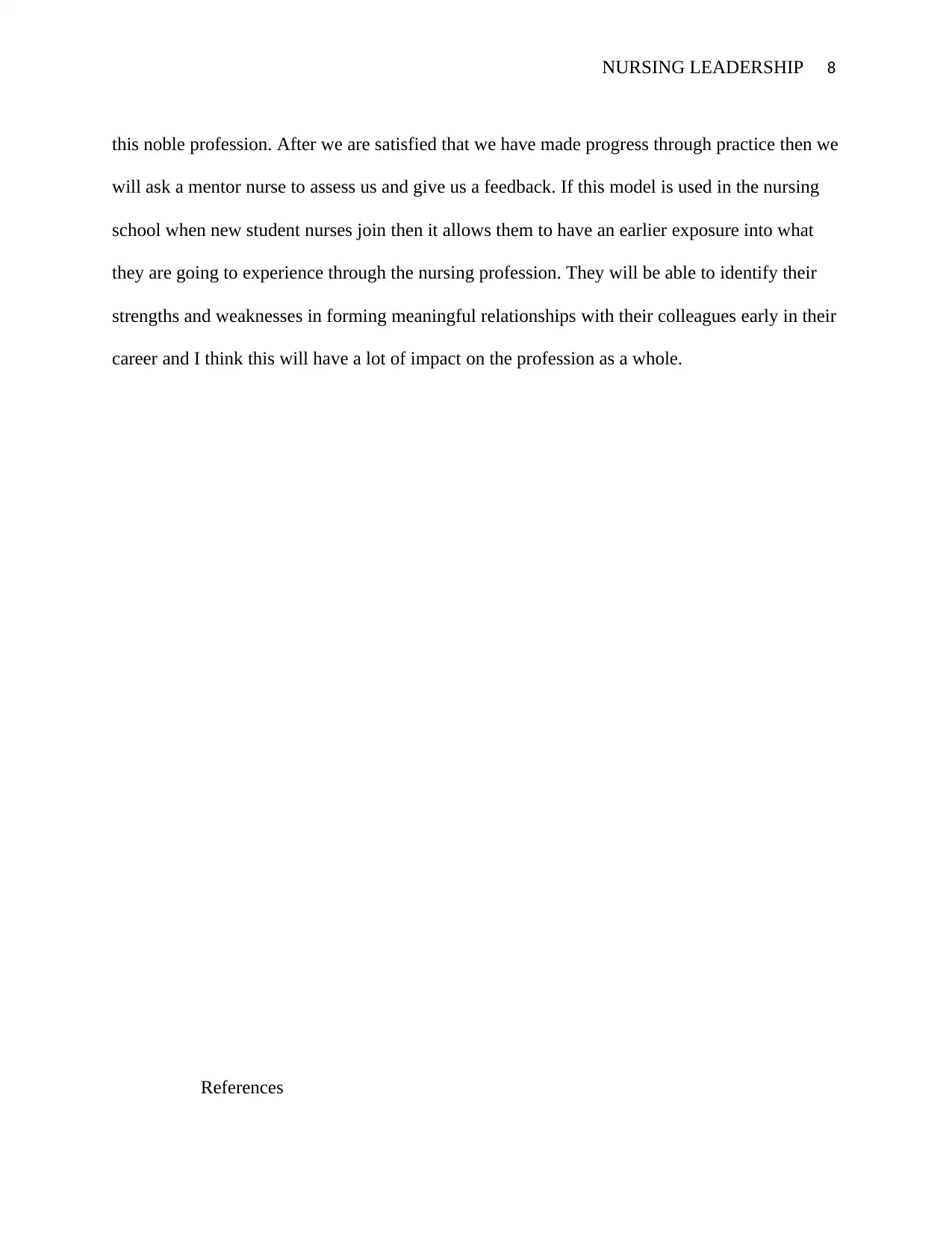
NURSING LEADERSHIP 8
this noble profession. After we are satisfied that we have made progress through practice then we
will ask a mentor nurse to assess us and give us a feedback. If this model is used in the nursing
school when new student nurses join then it allows them to have an earlier exposure into what
they are going to experience through the nursing profession. They will be able to identify their
strengths and weaknesses in forming meaningful relationships with their colleagues early in their
career and I think this will have a lot of impact on the profession as a whole.
References
this noble profession. After we are satisfied that we have made progress through practice then we
will ask a mentor nurse to assess us and give us a feedback. If this model is used in the nursing
school when new student nurses join then it allows them to have an earlier exposure into what
they are going to experience through the nursing profession. They will be able to identify their
strengths and weaknesses in forming meaningful relationships with their colleagues early in their
career and I think this will have a lot of impact on the profession as a whole.
References
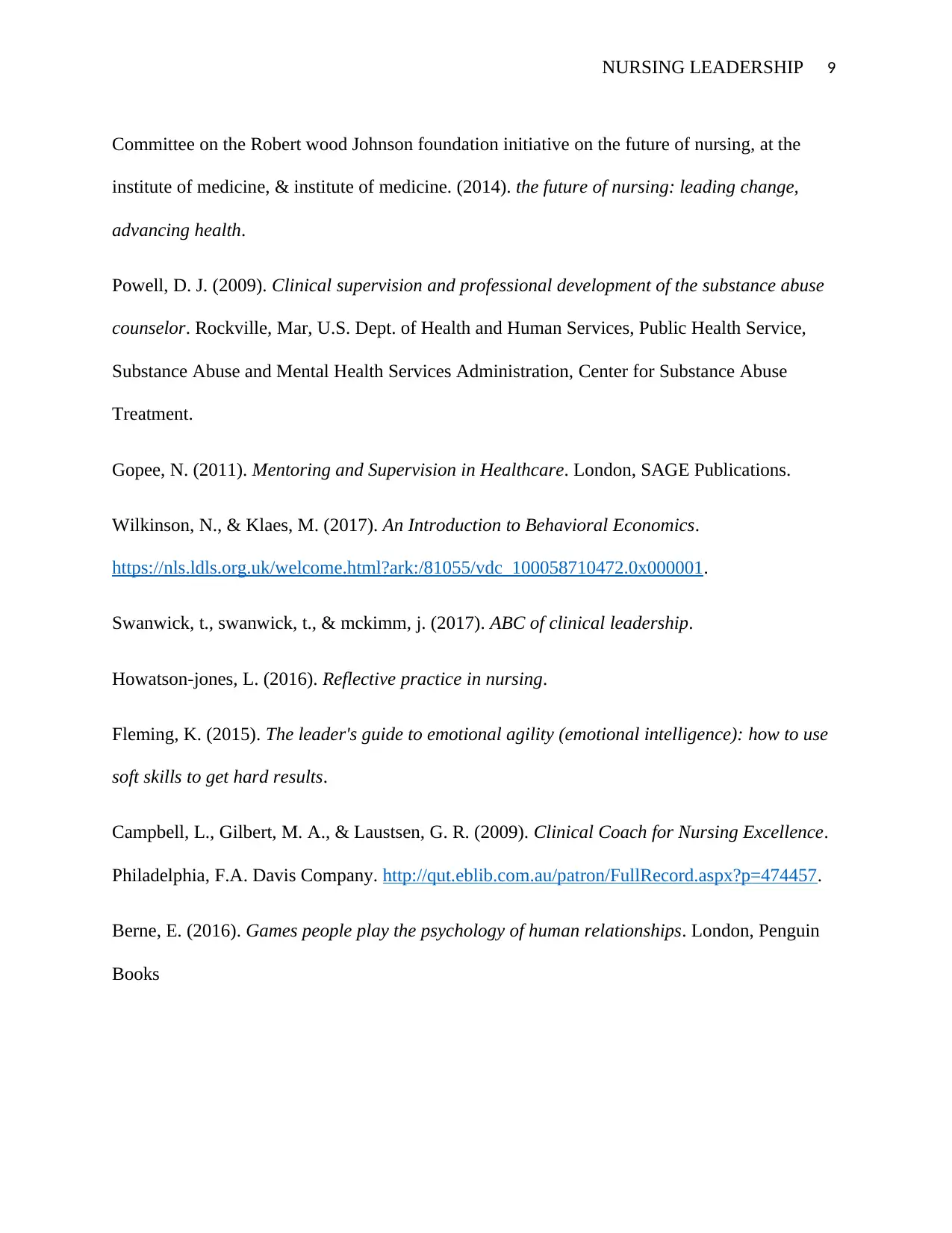
NURSING LEADERSHIP 9
Committee on the Robert wood Johnson foundation initiative on the future of nursing, at the
institute of medicine, & institute of medicine. (2014). the future of nursing: leading change,
advancing health.
Powell, D. J. (2009). Clinical supervision and professional development of the substance abuse
counselor. Rockville, Mar, U.S. Dept. of Health and Human Services, Public Health Service,
Substance Abuse and Mental Health Services Administration, Center for Substance Abuse
Treatment.
Gopee, N. (2011). Mentoring and Supervision in Healthcare. London, SAGE Publications.
Wilkinson, N., & Klaes, M. (2017). An Introduction to Behavioral Economics.
https://nls.ldls.org.uk/welcome.html?ark:/81055/vdc_100058710472.0x000001.
Swanwick, t., swanwick, t., & mckimm, j. (2017). ABC of clinical leadership.
Howatson-jones, L. (2016). Reflective practice in nursing.
Fleming, K. (2015). The leader's guide to emotional agility (emotional intelligence): how to use
soft skills to get hard results.
Campbell, L., Gilbert, M. A., & Laustsen, G. R. (2009). Clinical Coach for Nursing Excellence.
Philadelphia, F.A. Davis Company. http://qut.eblib.com.au/patron/FullRecord.aspx?p=474457.
Berne, E. (2016). Games people play the psychology of human relationships. London, Penguin
Books
Committee on the Robert wood Johnson foundation initiative on the future of nursing, at the
institute of medicine, & institute of medicine. (2014). the future of nursing: leading change,
advancing health.
Powell, D. J. (2009). Clinical supervision and professional development of the substance abuse
counselor. Rockville, Mar, U.S. Dept. of Health and Human Services, Public Health Service,
Substance Abuse and Mental Health Services Administration, Center for Substance Abuse
Treatment.
Gopee, N. (2011). Mentoring and Supervision in Healthcare. London, SAGE Publications.
Wilkinson, N., & Klaes, M. (2017). An Introduction to Behavioral Economics.
https://nls.ldls.org.uk/welcome.html?ark:/81055/vdc_100058710472.0x000001.
Swanwick, t., swanwick, t., & mckimm, j. (2017). ABC of clinical leadership.
Howatson-jones, L. (2016). Reflective practice in nursing.
Fleming, K. (2015). The leader's guide to emotional agility (emotional intelligence): how to use
soft skills to get hard results.
Campbell, L., Gilbert, M. A., & Laustsen, G. R. (2009). Clinical Coach for Nursing Excellence.
Philadelphia, F.A. Davis Company. http://qut.eblib.com.au/patron/FullRecord.aspx?p=474457.
Berne, E. (2016). Games people play the psychology of human relationships. London, Penguin
Books
⊘ This is a preview!⊘
Do you want full access?
Subscribe today to unlock all pages.

Trusted by 1+ million students worldwide
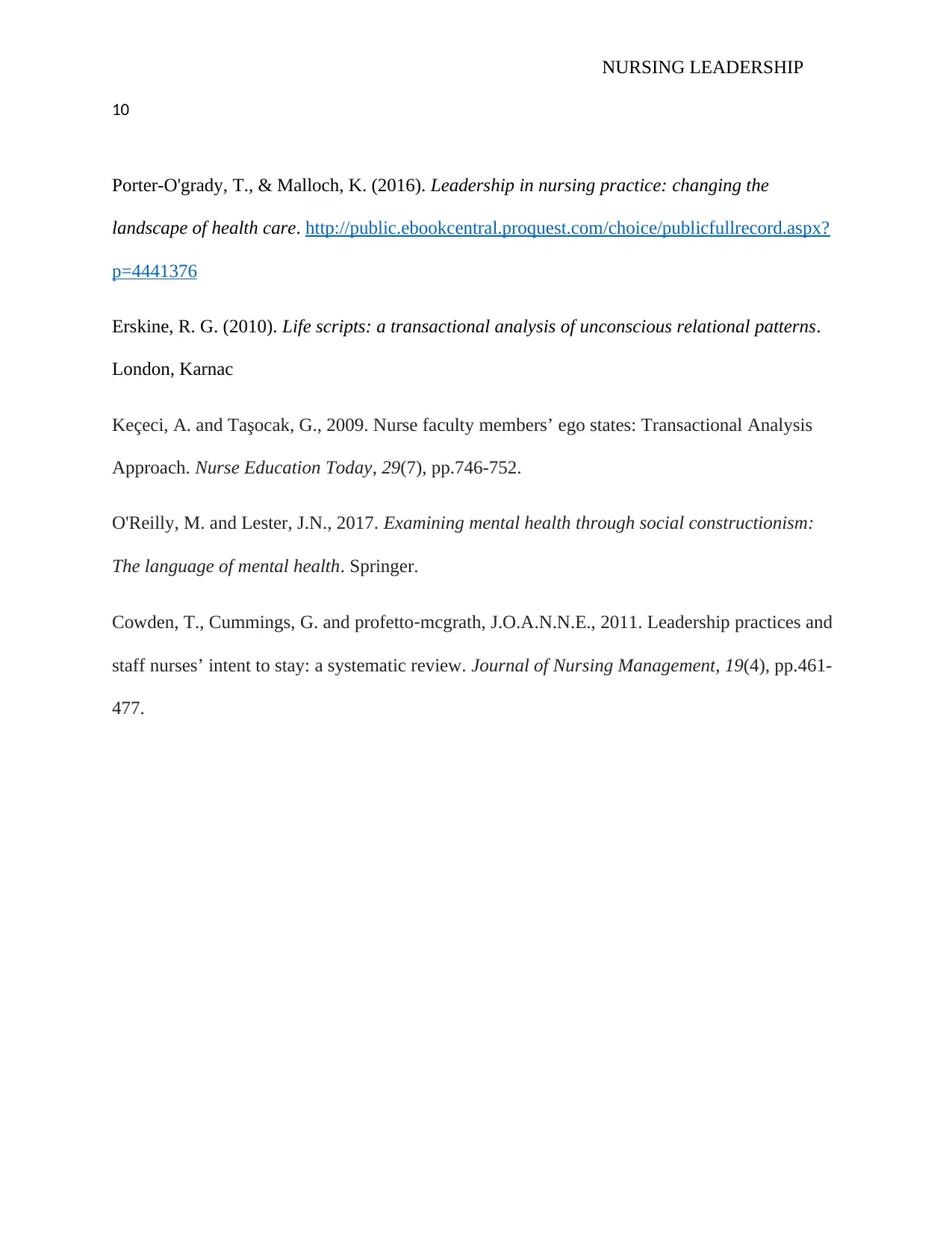
NURSING LEADERSHIP
10
Porter-O'grady, T., & Malloch, K. (2016). Leadership in nursing practice: changing the
landscape of health care. http://public.ebookcentral.proquest.com/choice/publicfullrecord.aspx?
p=4441376
Erskine, R. G. (2010). Life scripts: a transactional analysis of unconscious relational patterns.
London, Karnac
Keçeci, A. and Taşocak, G., 2009. Nurse faculty members’ ego states: Transactional Analysis
Approach. Nurse Education Today, 29(7), pp.746-752.
O'Reilly, M. and Lester, J.N., 2017. Examining mental health through social constructionism:
The language of mental health. Springer.
Cowden, T., Cummings, G. and profetto‐mcgrath, J.O.A.N.N.E., 2011. Leadership practices and
staff nurses’ intent to stay: a systematic review. Journal of Nursing Management, 19(4), pp.461-
477.
10
Porter-O'grady, T., & Malloch, K. (2016). Leadership in nursing practice: changing the
landscape of health care. http://public.ebookcentral.proquest.com/choice/publicfullrecord.aspx?
p=4441376
Erskine, R. G. (2010). Life scripts: a transactional analysis of unconscious relational patterns.
London, Karnac
Keçeci, A. and Taşocak, G., 2009. Nurse faculty members’ ego states: Transactional Analysis
Approach. Nurse Education Today, 29(7), pp.746-752.
O'Reilly, M. and Lester, J.N., 2017. Examining mental health through social constructionism:
The language of mental health. Springer.
Cowden, T., Cummings, G. and profetto‐mcgrath, J.O.A.N.N.E., 2011. Leadership practices and
staff nurses’ intent to stay: a systematic review. Journal of Nursing Management, 19(4), pp.461-
477.
1 out of 10
Related Documents
Your All-in-One AI-Powered Toolkit for Academic Success.
+13062052269
info@desklib.com
Available 24*7 on WhatsApp / Email
![[object Object]](/_next/static/media/star-bottom.7253800d.svg)
Unlock your academic potential
Copyright © 2020–2025 A2Z Services. All Rights Reserved. Developed and managed by ZUCOL.



